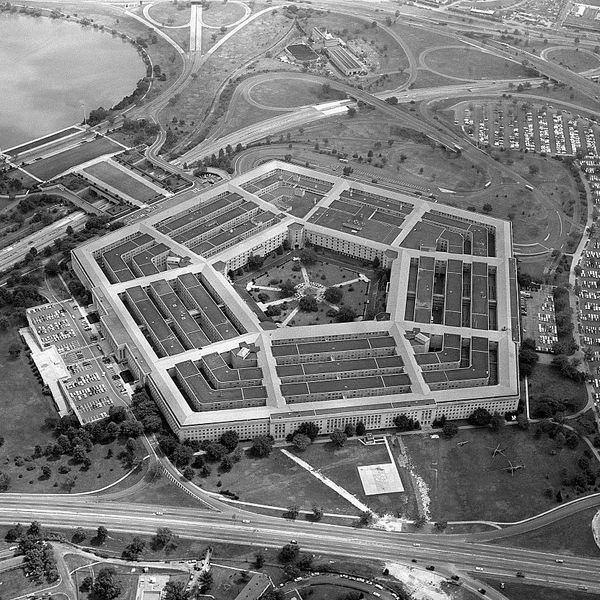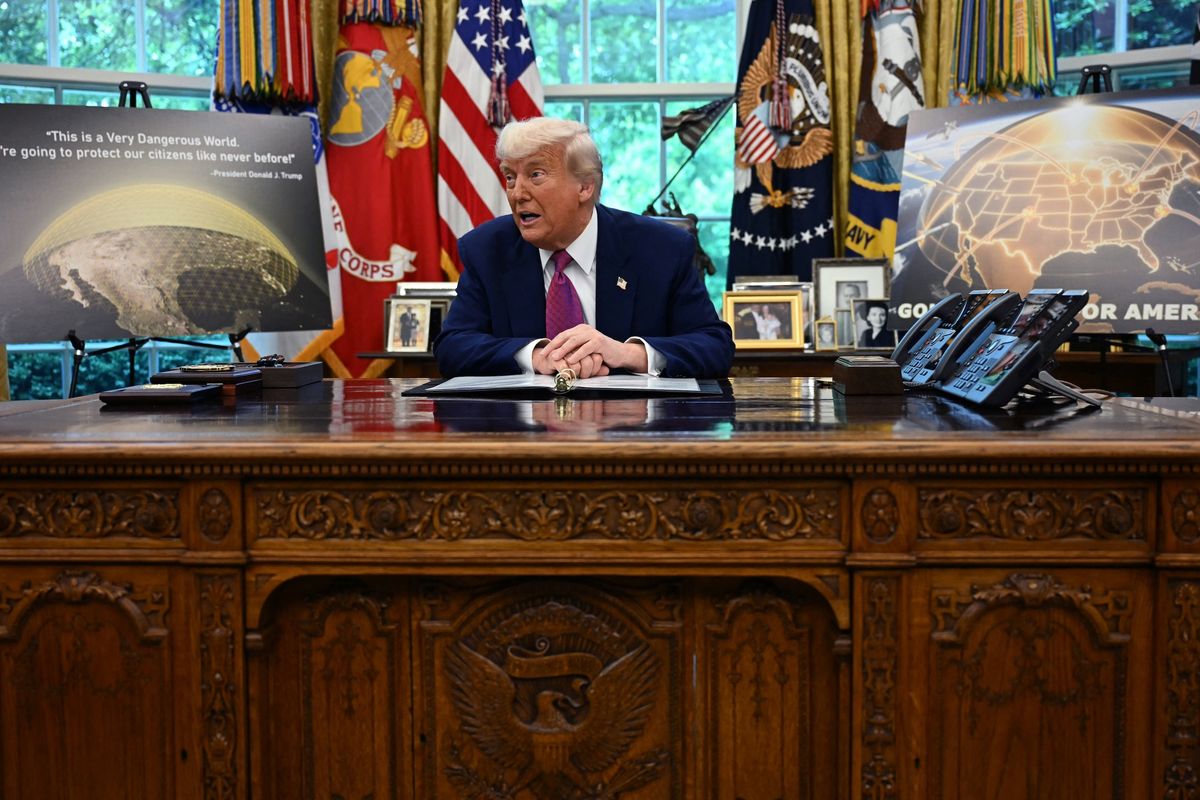OPINION — “On October 27, the Department of Defense announced that the United States will pursue a modern variant of the B61 nuclear gravity bomb, designated the B61-13, pending Congressional authorization and appropriation. The B61-13 will strengthen deterrence of adversaries and assurance of allies and partners by providing the President with additional options against certain harder and large-area military targets.”
That quote is from what the Pentagon described as a “Fact Sheet on B61 Variant Development,” but it needs to be translated into common English.
The true meaning is that the Biden administration will be seeking Congressional authorization and funds to build a new nuclear bomb. The weapon was described as a “modern variant” of the B61 in order to not call attention to the fact that the U.S. is in a nuclear arms race with Russia and China, both of whom are also building new nuclear weapons.
The words “strengthen deterrence…by providing the President with additional options against certain harder and large-area military targets,” sends an ominous warning that the new B61-13 nuclear bomb could be powerful enough to destroy any hardened, underground shelter in Moscow or Beijing (where Russian and/or Chinese leaders may be planning to hide) along with command and control centers, should they dare to start a nuclear war.
The Pentagon statement also said the B61-13 “would replace some of the B61-7s in the current nuclear stockpile and have a yield similar to the B61-7, which is higher than that of the B61-12.”
Although the Pentagon used the word “yield,” which refers to the quantity of TNT generated when the nuclear weapon is detonated, it did not provide a number which would help us better understand how powerful the new bomb would be.
I believe it’s time we attached numbers to the yields of nuclear weapons to be transparent about their massive destructive power - both immediate and long-term - rather than just talking about building them.
I also believe the decision to move to the B61-13 is being made to allow for the retirement of the 40-year-old B83-1 nuclear bomb, currently the most powerful bomb in the U.S. stockpile. It has a top yield of 1.2 megatons – the equivalent of 1.2 million tons of TNT. That is 80 times the power of the Hiroshima atomic bomb. The role of the B83-1 has been to obliterate hardened, underground military sites and command bunkers.
Get an up close with some of the greatest minds in cyber at the Cyber Initiatives Group’s virtual Winter Summit, Wednesday, December 6 from 12p – 3p ET. Save my seat.
In 2010, the Obama administration announced it would retire the B83-1, saying it would be replaced by the B61-12. However, the Trump administration in its 2018 Nuclear Posture Review reversed that decision and called for the B83-1 to be sustained “until a suitable replacement is identified.”
There is a B61-11 that came into service in 1997, designed as an earth penetrating nuclear weapon for the B2 stealth bomber to attack underground and hardened targets. It has a yield of 360 kilotons [equal to 360 thousand tons of TNT]. Only 50 were produced by converting B61-7s.
At that time, the then head of Strategic Command said, “All we have done is put the components into a case-hardened steel shell that has the capability of burrowing quite a ways underground, through frozen tundra, through significant layers of concrete."
The Biden 2022 Nuclear Posture Review called for retirement of the B83-1 and said the Defense Department (DoD) was developing “an enduring capability” to defeat hard and deeply buried targets.
Enter the B61-13 with a yield “similar to the B61-7,” which I have read, can dial up yields from as low as 10 kilotons to 360 kilotons, each kiloton representing the explosive power of one thousand tons of TNT.
What can a new B61-13 do when it is built and added to the U.S. nuclear arsenal?
To answer that question, I turned to Alex Wellerstein, Associate Professor of Science and Technology Studies at the Stevens Institute of Technology in Hoboken, N.J. He is also the creator of a web-based nuclear weapons effects simulator introduced in 2012.
I asked Wellerstein to use his NUKEMAP simulator to show what one proposed B61-13 would do if it were dropped on Beijing, for example, for a surface detonation and was used to go after an underground hiding place for Chinese leaders or the command center to the People’s Liberation Army, should a U.S. President authorize such a nuclear strike.

The simulator showed that a surface burst of that single B61-13 would create a crater over 200 feet deep and roughly five football fields wide.
Its fireball alone, would cover 80 percent of one square mile. Inside the fireball, everything would be “effectively vaporized,” according to the NUKEMAP simulation. Heavy blast damage would occur within an estimated 2.8 square miles and would include “heavily built concrete buildings…severely damaged or demolished,” while “fatalities [would] approach 100 percent.”
Thermal heat from the detonation would create the threat of third-degree skin burns to exposed people within 3 square miles. Moderate blast damage from that one B61-13 would collapse most residential buildings in a surrounding 12.4 square-mile area, along with spreading fires that would create widespread fatalities.
In the directly affected area of Beijing, which normally be home to some 3 million people in a 24-hour period, the NUKEMAP simulation estimates that 422,580 people would die, while another 948,280 would be injured.
This surface blast with the fireball hitting the ground would create extensive, deadly radioactive fallout that would be drawn up from the giant ground crater. That deadly material would then rise up through the stem and into the mushroom cloud which would rise tens of thousands of feet, spreading out into the air before being carried away by the winds.

The NUKEMAP simulation shows that within 5.75 square miles of the surface detonation, a likely dosage from radioactive fallout from the stem and bottom of the mushroom cloud would be potentially fatal for more than 60 percent of fully exposed humans either immediately or within a month. At least 15 percent of those who survive would likely eventually die of cancer from that exposure.
With a 15-miles-per-hour wind, radioactive fallout during the first hour after detonation could prompt nausea and vomiting in victims up to 66 miles downwind and over a cigar-shaped area nine miles wide at its greatest size. Deaths would be minimal. Radioactive fallout of a lesser nature would travel as far as 169 miles from the detonation and would expand to 30 miles in width.
The long-term effects of that radioactive fallout would depend on the people and areas affected. As I explained in my 2021 book Blown To Hell, some Marshall Islanders were exposed to five hours of fallout from a U.S. nuclear test in 1954, that was detonated 120 miles away.
Nine years after their exposure, most of the younger Marshallese began showing potential cancerous growths on their thyroids, which then had to be removed. Some vegetation on their islands and fish and crustaceans in surrounding waters still, near 70 years later, show some higher-than-normal radiation levels.
Last month, in an article titled The Dawn of Our Nuclear Wake-up Call, I wrote about a list of proposals in the final report of the 12-member bipartisan Congressional Commission on the Strategic Posture of the United States. They called for an increase in future nuclear delivery systems and nuclear warheads based on facing in the future, two nuclear peer adversaries, Russia and China.
One week ago, the Center for Strategic and International Studies released a report, Project Atom 2023, which included an essay, “U.S. Nuclear Policy in a Two Peer Nuclear Adversary World,” by Franklin C. Miller, who was a member of the above-mentioned Congressional Commission. Miller, a Principal of The Scowcroft Group, served over 30 years in the Defense Department and is considered a leading expert on nuclear weapons.
It's not just for the President anymore. Cipher Brief Subscriber+Members have access to their own Open Source Daily Brief, keeping you up to date on global events impacting national security. It pays to be a Subscriber+Member.
In discussing “whether the United States’ strategic nuclear force is sufficient,” Miller wrote that the answer “should be whether it allows the [U.S.] to hold at risk the valued assets of the Russian, Chinese, and North Korean leaderships and to maintain an adequate reserve force.” He added, that “the idea that the United States must maintain ‘parity’ or rough equivalence with Russian or Chinese nuclear force levels should not be a factor in force sizing.”
For Miller, as with the Congressional Commission, “To continue to deter effectively today and for the foreseeable future, the United States must credibly continue to hold at risk what potential enemy leaders value most: themselves [emphasis added], the security forces which keep them in power, their military forces, and their war-supporting industry.”
Notice the first on the list as most valued is the leadership, and thus a rationale for the B61-13.
Given the destructive power of a single B61-13, how many are needed to deter the leaders of China and Russia from using any of their nuclear weapons? Neither the Congressional Commission nor Miller answered that question and not surprisingly, the Pentagon has not disclosed how many are to be produced.
A final thought on this: the U.S. nuclear force might better serve the cause of deterrence if the announcement of new weapons such as the B61-13 were accompanied by a disclosure of yield - its destructive power, along with the number to be produced.
The Cipher Brief is committed to publishing a range of perspectives on national security issues submitted by deeply experienced national security professionals.
Opinions expressed are those of the author and do not represent the views or opinions of The Cipher Brief.
Have a perspective to share based on your experience in the national security field? Send it to Editor@thecipherbrief.com for publication consideration.
Read more expert-driven national security insights, perspective and analysis in The Cipher Brief












